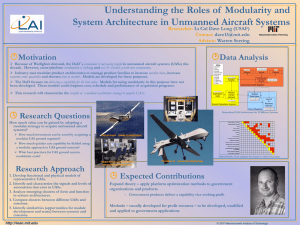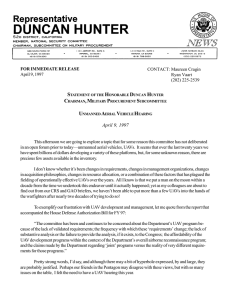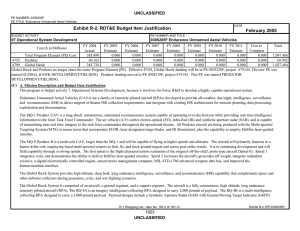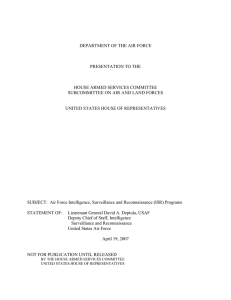House Armed Services Committee – TACAIR and Land Subcommittee
advertisement
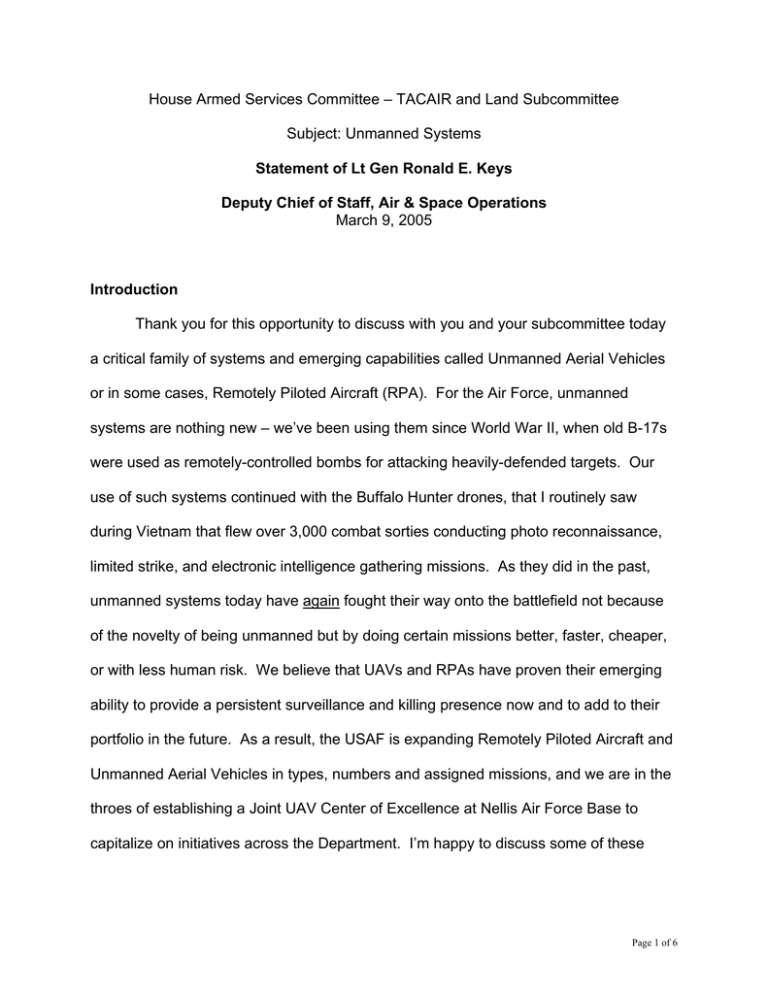
House Armed Services Committee – TACAIR and Land Subcommittee Subject: Unmanned Systems Statement of Lt Gen Ronald E. Keys Deputy Chief of Staff, Air & Space Operations March 9, 2005 Introduction Thank you for this opportunity to discuss with you and your subcommittee today a critical family of systems and emerging capabilities called Unmanned Aerial Vehicles or in some cases, Remotely Piloted Aircraft (RPA). For the Air Force, unmanned systems are nothing new – we’ve been using them since World War II, when old B-17s were used as remotely-controlled bombs for attacking heavily-defended targets. Our use of such systems continued with the Buffalo Hunter drones, that I routinely saw during Vietnam that flew over 3,000 combat sorties conducting photo reconnaissance, limited strike, and electronic intelligence gathering missions. As they did in the past, unmanned systems today have again fought their way onto the battlefield not because of the novelty of being unmanned but by doing certain missions better, faster, cheaper, or with less human risk. We believe that UAVs and RPAs have proven their emerging ability to provide a persistent surveillance and killing presence now and to add to their portfolio in the future. As a result, the USAF is expanding Remotely Piloted Aircraft and Unmanned Aerial Vehicles in types, numbers and assigned missions, and we are in the throes of establishing a Joint UAV Center of Excellence at Nellis Air Force Base to capitalize on initiatives across the Department. I’m happy to discuss some of these Page 1 of 6 programs with you today. Unmanned Systems in General Although we have a tendency to focus on the air vehicle when we discuss RPA/UAVs, it is important we don’t lose sight that RPA/UAV capability encompasses far more than just an air vehicle. We must consider the sensors; the actual control stations, the launch and recovery ground stations; the people who maintain the system and operate the sensors and weapons; and the command and control and data interoperability with other systems that are essential to integrate UAVs with the joint force. Predator Used in every Air Force operation since 1995, Predator has amassed over 100,000 flying hours, 80% of which were flown operationally. The MQ-1, or Predator A, is currently supporting eight Operation Enduring Freedom and Operation Iraqi Freedom 24/7 orbits, which is an increase to meet expanding requirements. We are working to provide even greater combat capability by growing to twelve Predator orbits late this year. Over the past 12 months, we have maintained an average mission capable rate of 83%, and since FY02, we averaged 6.3 losses per year, which includes aircraft lost to enemy action. Currently we have 59 Predators on hand with 26 deployed and acquiring 1.5 per month. Today, with both U.S.- based and deployed flight and mission control, Predator is truly providing a revolutionary leap in how we provide military capability downrange. The MQ-1 continues to transform warfighting; providing persistent ISR, target acquisition, and strike capabilities against time sensitive targets. Equipped with an Page 2 of 6 electro-optical, infrared, and laser designator sensor, and armed with Hellfire missiles, Predator not only shortened the sensor-to-shooter timeline – the sensor is now the shooter. In order to further multiply our combat effectiveness, we are developing the ability to operate multiple aircraft from a single ground station and expect to have that on line by October of this year. Our next step is the ongoing development of the MQ-9 Predator B ‘Hunter-Killer’, of which one, soon to be two, prototypes are engaged in the Global War on Terrorism armed with GBU-12 laser guided bombs. As we work through the test program, we expect to field the “B” as a faster, higher flying UAV capable of automatically cueing and prosecuting critical emerging time sensitive targets with a self-contained hard-kill capability to include JDAM (Joint Direct Attack Munition) and Small Diameter Bomb GPS precision-guided munitions as well as self-designating for both Hellfires and Laser Guided bombs. To date, the MQ-9 has flown over 700 hours with no losses. Currently we have six prototype Predator B models with one deployed. Global Hawk The RQ-4 Global Hawk is a high altitude, long endurance, remotely piloted aircraft that provides persistence surveillance and reconnaissance capabilities. Through the innovative use of synthetic aperture radar and electro-optical and infrared sensors, Global Hawk provides the warfighter unrelenting observation of intelligence targets in night, day, and adverse weather. Since its first flight in 1998, Global Hawk has flown over 6,300 hours – over half of that time in combat and has been in constant demand by Combatant Commanders. Page 3 of 6 The Global Hawk ACTD (Advanced Concept Technology Demonstration) system has been deployed three times, completing 179 combat missions and continues to provide superior ISR data while deployed in support of the Global War on Terrorism with a 94% mission effectiveness rate. Our ACTD aircraft have experienced three losses, two of which were during operational use. That may seem high, however if we scaled this to the metric of a mature fleet, it is very similar to manned aircraft programs in their early stages of development. Our goal is 51 production aircraft and 10 ground stations. As we proceed, Global Hawk will be equipped with an enhanced integrated sensor suite of electro-optical, infrared and synthetic aperture radar, as well as a more robust SIGINT capability. Cruising at extremely high altitudes, Global Hawk can collect information on spot targets and survey large geographic areas, providing military decision-makers the most current information about enemy location, resources, and personnel. Global Hawk is the only UAV that can provide GPS quality coordinates for precision guided munition employment. As was seen most notably during the Sand Storm in Operation Iraqi Freedom, dissemination and ground support exploitation systems consistently deliver timely intelligence to bring immediate advantage to combat operations. Small UAVs The Air Force is also pursuing a “family of systems” concept to allow flexibility at all levels for the use of small UAVs. Small UAVs are rapidly growing in type, and offer a versatile family of capabilities supporting all AF CONOPs (Concepts of Operation). Our four classes of small UAVs (Micro, Man Portable, Multi-Mission and Air Launched) provide situational awareness capabilities primarily to AF Special Operations Command Page 4 of 6 missions, as well as security for airfields. Aircraft in our current inventory include 44 BATCAM, 116 Pointer/Raven and 126 Desert Hawk. Joint Unmanned Combat Air System (J-UCAS) The Air Force has also emphasized the Persistent Ground Attack mission for the next-generation as the new lead on the Joint Unmanned Combat Air System capability demonstration program. This system will undergo an operational assessment beginning in 2007. Standing together with the United States Navy and leveraging the great work already done by DARPA, we are emphasizing those technical areas that are challenges for current and future unmanned aircraft, such as automated aerial refueling, interoperability with manned aircraft, automated and flexible routing, cooperative operations and carrier suitability. We have the expectation that the J-UCAS family will father the first UAVs planned to replace manned systems for deep attack, suppression and destruction of enemy air defenses electronic attack penetrating ISR, and nearly autonomous close air support. Through FY05, DoD has funded approximately $1.2B with plans for an additional $4.1B through the FYDP for this joint program. Aerostat Systems Let me turn to an interesting related topic that has lead us to a “non-traditional” look at UAV possibilities. The Air Force serves as executive agent and provides program oversight of eight operational aerostats positioned along the US southwest border, Florida Keys and Puerto Rico, supporting the Deputy Assistant Secretary of Defense for Counternarcotics. Although Aerostat Systems are typically not thought of as UAVs they do open up possibilities of affordable systems that offer a persistent view of areas large or small and the information can be used for missions such as air base Page 5 of 6 defense and the detection and monitoring from landborne intruders or terrorists, to drug trafficking aircraft. As the result of our experience with aerostats, the Air Force significantly influenced the development and deployment of the Persistent Threat Detection System (PTDS) inside Iraq. This system detects certain missile, mortar and rocket propelled grenade launches to facilitate Air Base Defense, as well as the monitoring of main supply routes for detection of Improvised Explosive Devices. Once we got that far, it was not a great intellectual leap into what we call “Near Space.” Near Space The sub-orbital Near Space environment, defined as 65,000 to 325,000 feet above the earth offers an operating area where the Air Force can take advantage of new communications and ISR capabilities to support the warfighter. Due to the operating altitude of Near Space vehicles, we foresee the ability to observe and communicate over large areas of the Earth with vehicles that station keep for weeks and months if not longer. We believe that this may prove to be the next great step in UAV operations. Conclusion In summary, we believe UAVs and RPAs are the future of our force and are committed to them. They give us operational capability today in a persistent, precise way and hold the promise of more capability in the future. The key requirements are operational relevance and battlefield capability… the key parameters must be a leveraged calculation of faster, cheaper, better as applied to the Combatant Commanders’ requirements. We appreciate your support in turning this vision into an operating reality. Page 6 of 6

